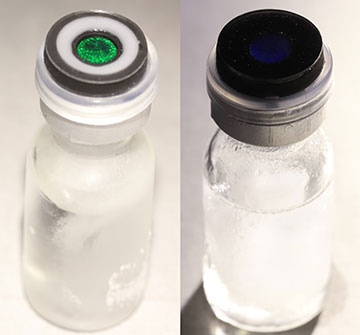
Appearing green on a vial lid (left), the structural-color material becomes colorless (right) when warmed. [Image: Adapted from ACS Nano 2023, doi: 10.1021/acsnano.3c00467]
Vaccines stored in environments that are too cold or too hot will lose potency, meaning that transporting them worldwide often requires a chain of precisely coordinated events. Time–temperature monitoring can indicate whether a vaccine has been exposed to abnormal temperatures at some point along the cold chain.
Now researchers in the United States and China have developed a class of structural-color materials that holds promise for creating the next generation of time–temperature indicators (ACS Nano, doi: 10.1021/acsnano.3c00467). The proof-of-concept study demonstrates their wide tracking temperature range, high sensitivity and excellent stability.
A need for cold storage
From the time they are manufactured to the moment they are injected, vaccines need to be kept within a limited temperature range. Conventional vaccines require storage temperatures of 2 °C to 8 °C, while messenger ribonucleic acid (mRNA) vaccines must be frozen at subzero temperatures to avoid degradation.
However, current material-based time–temperature indicators suffer from limited reliability and stability. Some have narrow tracking temperature ranges, while others are inapplicable to subzero temperatures. Electronic time–temperature indicators, on the other hand, demand human intervention and generate significant amounts of waste.
Xuemin Du and his colleagues aimed to explore new materials for improved time–temperature monitoring of vaccines and other medications. “We developed a class of structural-color material, termed self-destructive structural-color liquids, that harnesses advantages of both fluidic nature and structural color,” said study author Du, a professor at the Shenzhen Institutes of Advanced Technology, Chinese Academy of Sciences.
Next-generation indicators
The self-destructive structural-color liquids consist of two components: nontoxic polyethylene glycol (PEG) or ethylene glycol (EG) aqueous solutions and brilliant liquid colloidal photonic crystals. The PEG or EG aqueous solutions, which have high sensitivity to specific temperatures and were mixed to produce liquids with variable melting points, act as triggering agents, while the colloidal photonic crystals act as an indicating agent.
The photonic crystals ordinarily appear bright green or red, but when the self-destructive structural-color liquids reach their melting point, the crystals break apart and produce an irreversible color loss.
The photonic crystals ordinarily appear bright green or red, but when the self-destructive structural-color liquids reach their melting point, the crystals break apart and produce an irreversible color loss. As a result, the materials have the ability to indicate time–temperature history, with a wide tracking temperature range (−70 °C to +37 °C) and largely tunable self-destructive time (40 minutes to 5 days).
The researchers tested the materials in the form of time–temperature indicators on conventional vaccines (storage temperature: 8 °C), mRNA vaccines (−20 °C and −70 °C) and transported organs (0 °C). The technology demonstrated high sensitivity and successfully indicated when the products became too warm.
“The gradual color changes and reflectance spectra shift provide a synergistic strategy for qualitatively and quantitatively revealing the accurate time–temperature history of various vaccines,” said Du. “Our self-destructive structural-color liquids overcome the disadvantages inherent in conventional time–temperature indicators, bringing them one step closer to the cold supply chain.”
